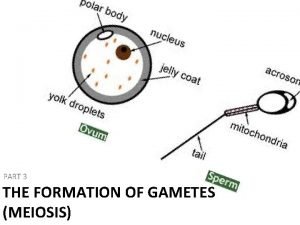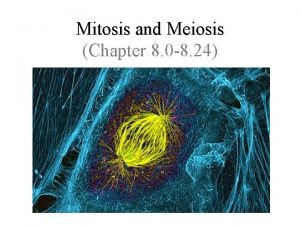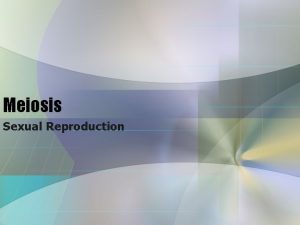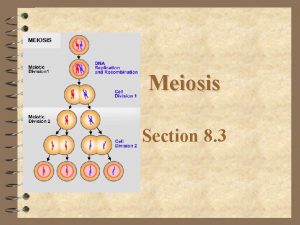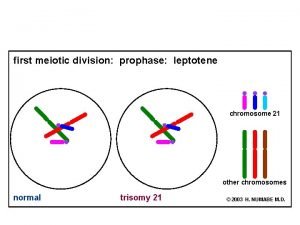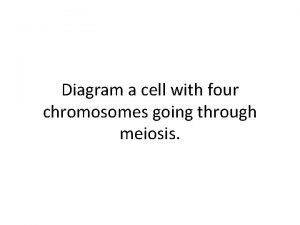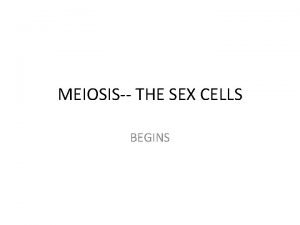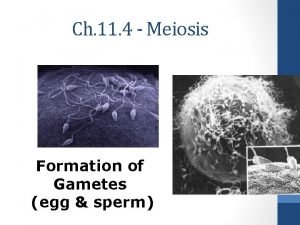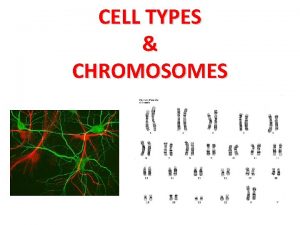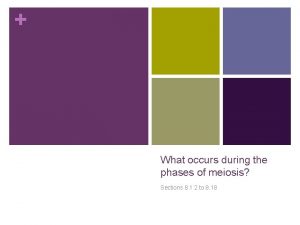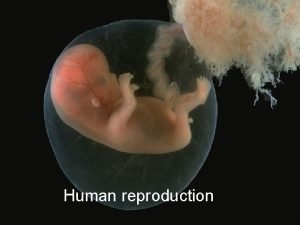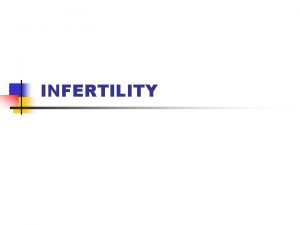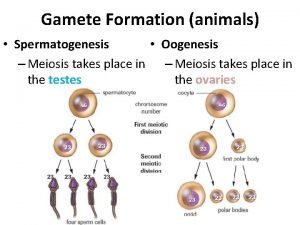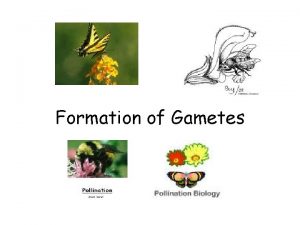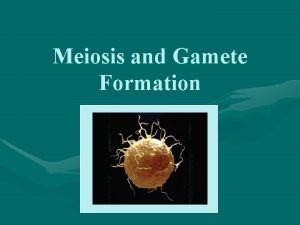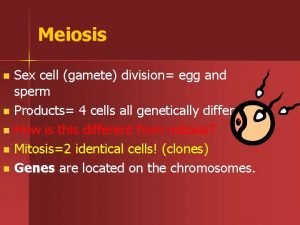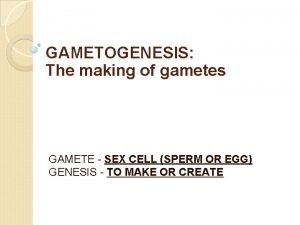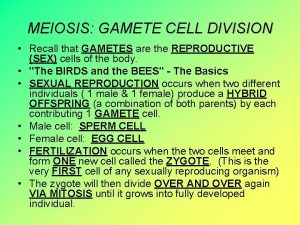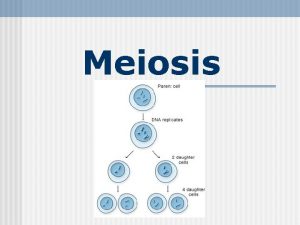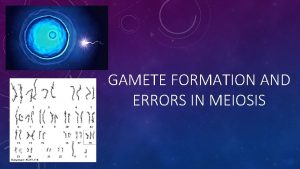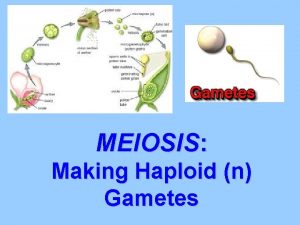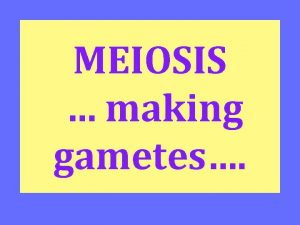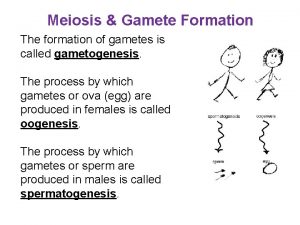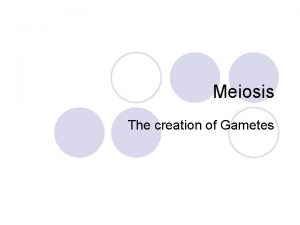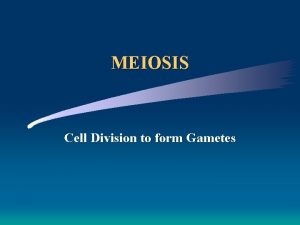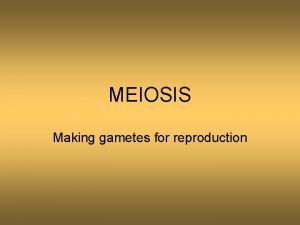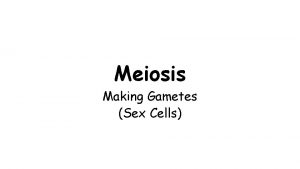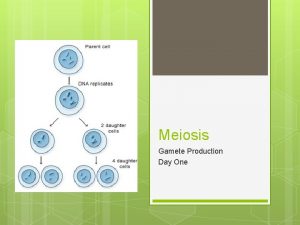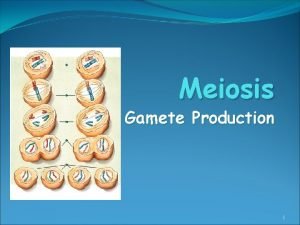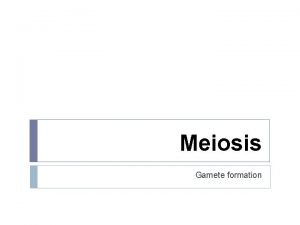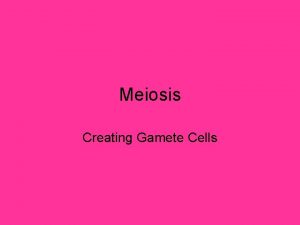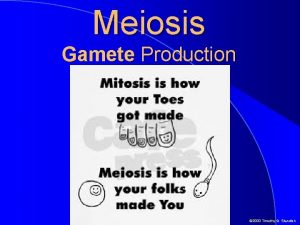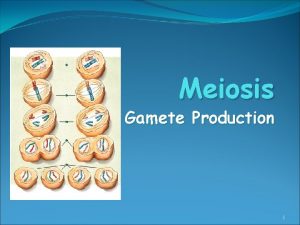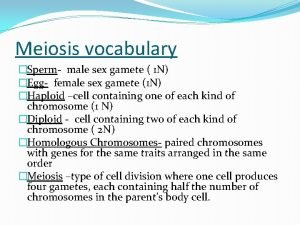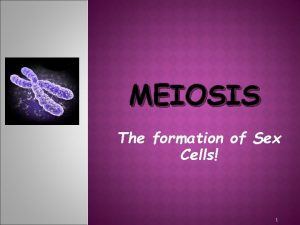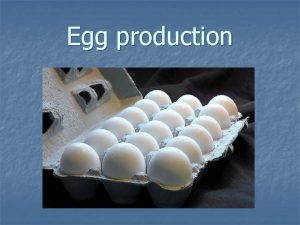MEIOSIS making gametes Gamete sex cell egg and





































- Slides: 37

MEIOSIS … making gametes….

• Gamete = sex cell (egg and sperm) • Each gamete has 1 set of 23 chromosomes • When they come together, the resulting cell has 46 chromosomes 23 23 • Somatic cell = body cells (all cells except eggs and sperm)

Each of your somatic (body) cells has 2 sets of chromosomes – one from mom, one from dad. Any cell that has 2 complete sets of chromosomes is said to be DIPLOID (2 n) Cells with 1 set of chromosomes (gametes) are said to be HAPLOID (n) When 2 gametes come together in fertilization, they make a zygote. The zygote is diploid and has 46 chromosomes.

Practice! • If a goldfish’s diploid number is 42, what is its haploid number? • If a turtle’s sperm cell has 50 chromosomes, how many chromosomes would a turtle’s skin cell contain? (Sperm cells are gametes, which are haploid. Skin cells are somatic cells, which are diploid. )

What type of cells produce eggs and sperm? Ovarian and testicular cells!

Why do ovary and testes cells go through meiosis? Meiosis is “reduction division”. During Why do meiosis? cell division, it reduces the chromosome number in the gametes by half. From diploid (2 n) to haploid (n).

Meiosis is… • The process of nuclear division that reduces the number of chromosomes by half – Somatic cell Gamete • Making the cells that make babies! (egg and sperm)

Homologous Chromosomes (pairs) In each somatic (body) cell you have 23 homologous pairs • Similarities: length, centromere location, coded traits, banding pattern • Differences: one chromosome from each parent


Homologous Chromosomes have the same banding pattern

Karyotype - picture of all chromosomes in the nucleus of 1 cell Used to determine: 1. If there is an abnormality in number or structure of the chromosomes (e. g. Down’s syndrome) 2. Gender




Diploid ovarian cell 2 n How you got here: MEIOSIS Diploid Testicular cell 2 n MEIOSIS egg (n) sperm (n) fertilization zygote MITOSIS You

Products of MITOSIS: 2 identical diploid 2 n 2 n + 2 n (2 n) cells Products of MEIOSIS: 4 unique haploid (n) cells 2 n n + n + n

1. In streptomycin fungus n = 11. What is the diploid number for this species? 2. If n = 15 for goldfish, how many chromosomes would be in a fin cell? 3. If 2 n = 108 for black spruce trees, what is the haploid number? 4. During MITOSIS, the chromosomes A. are located at the cell equator during prophase B. are located at the cell equator during telophase C. move toward the poles of the cell during anaphase D. move toward the poles of the cell during metaphase

Meiosis II Meiosis I

MEIOSIS I Before Interphase 1. INTERPHASE I: Period of cell growth and preparation for division (G 1, S, G 2) Homologous chromosome pair 2. PROPHASE I: a. Tetrads appear b. Crossing Over (synapsis) occurs - tetrad After interphase Crossing over Recombinant chromatids

METAPHASE I: Tetrads (2 homologous chromosomes) line up on metaphase plate and lock on to spindle fibers ANAPHASE I: Spindle fibers pull tetrads (chromosome pairs) apart. Independent assortment occurs.

TELOPHASE I: nuclear membranes form around the two new nuclei CYTOKINESIS I: cell splits in half. Result = 2 haploid cells

MEIOSIS II

Special Interphase between the two divisions: NO replication!!! - nothing changes with the chromosomes between telophase I and prophase II

Prophase II: Sister chromatids condense from chromatin. Metaphase II: Sister chromatids line up on equator Anaphase II: Sister chromatids are pulled apart. Telophase II: Nuclear membranes form.

Cytokinesis II: cytoplasm divides Total product is 4 haploid (n), genetically DIFFERENT gametes

Why Meiosis is important: • It creates Genetic Recombination (variety) –Resulting from: • crossing over • independent assortment

Crossing Over Exchange of genetic material between homologous chromosomes during Prophase I Notice that these chromosomes have been duplicated. When does DNA replication happen?

Independent Assortment Creating a random mix of genes in each gamete, based on how tetrads line up at Metaphase I

https: //www. youtube. com/watch? v=16 en. C 385 R 0 w http: //www. cellsalive. com/meiosis. htm https: //www. youtube. com/watch? v=i. CL 6 d 0 Ow. Kt 8

Meiosis vs. Mitosis • Used for Sexual Reproduction • Produces Gametes (Egg & Sperm) – Have 23 chromosomes • 2 sets of divisions • Begins with a diploid cell • Homologous chromosomes pair up • Result: 4 genetically different HAPLOID SEX cells • Used for Growth and Asexual Reproduction • Produces body cells – Have 46 chromosomes – Somatic cells • • One round of division Begins with diploid cells No crossing over Homologous chromosomes don’t pair up • Results in 2 genetically identical DIPLOID SOMATIC cells (Now, fill in your Venn Diagram!)

Chromosome number questions… 1. If a horse retina (eye) cell has 36 chromosomes, how many does a horse egg cell have? 2. If n = 4 for fruit flies, how many chromosomes does a wing cell have? 3. If the 2 n number of a pine tree is 86, how many chromosomes would be found in a pine ovum (egg)?

Non-disjunction Non-separation of chromosomes resulting in diploid or empty gametes • When it happens in Meiosis I: • All 4 gametes affected • When it happens in Meiosis II: • Half of gametes affected


Conditions caused by non-disjunction Down’s syndrome = Trisomy 21 - 3 copies of chromosomes 21 equaling a total of 47 (2 n + 1) chromosomes. • chance of occurring in oogenesis increases with maternal age Turner’s syndrome = Monosomy X - has only one X chromosomes equaling a total of 45 (2 n-1) chromosomes in her body cells.

Down’s syndrome – Trisomy 21 A simple check for the presence of a bone in the nose could more accurately test unborn babies for Down's syndrome, scientists say. Researchers say combining the nose test with existing screening methods (amniocentesis) could lead to a five-fold reduction in the number of miscarriages linked to an invasive procedure used to confirm Down's syndrome.

Turner’s syndrome X -Caused by missing or incomplete X chromosome -Genes affected are involved with growth and sexual development -May fail to start puberty -Shorter than normal -Treatment = Hormone Replacement Therapy

Klinefelter’s syndrome XXY Normal boy who develops some female secondary sex characteristics at puberty. -slightly lower IQ, infertile, delayed motor, speech, maturation -treated with testosterone
 Kurt bumby
Kurt bumby Sex snv
Sex snv Sex sex sex
Sex sex sex Sex sex sex
Sex sex sex Sex sex sex
Sex sex sex When does crossing over occur
When does crossing over occur Meisosis
Meisosis Meiosis square dance
Meiosis square dance Meiosis reproduction
Meiosis reproduction Meiosis diagram
Meiosis diagram Four chromosomes going through mitosis
Four chromosomes going through mitosis Importance of meiosis
Importance of meiosis Gametic cells vs somatic cells
Gametic cells vs somatic cells Law of segregation vs law of independent assortment
Law of segregation vs law of independent assortment Sex linkage example
Sex linkage example Sex rat
Sex rat Sex determination and sex linkage
Sex determination and sex linkage Concept mapping chapter 10 meiosis 1 and meiosis 2
Concept mapping chapter 10 meiosis 1 and meiosis 2 Differences between mitosis and meiosis
Differences between mitosis and meiosis Chapter 10 section 1 meiosis
Chapter 10 section 1 meiosis Chapter 10 section 1: meiosis
Chapter 10 section 1: meiosis Once a sex offender always a sex offender
Once a sex offender always a sex offender West egg and east egg in real life
West egg and east egg in real life West egg and east egg
West egg and east egg Great gatsby locations map
Great gatsby locations map West egg and east egg
West egg and east egg West egg and east egg
West egg and east egg Anaphase
Anaphase Meiosis 1
Meiosis 1 Meiosis 1 vs meiosis 2
Meiosis 1 vs meiosis 2 What is the difference between somatic and gamete cells
What is the difference between somatic and gamete cells Gamete and zygote
Gamete and zygote Male and female gamete
Male and female gamete East and west egg
East and west egg Examples of symbolism in the great gatsby
Examples of symbolism in the great gatsby Gamete intrafallopian transfer
Gamete intrafallopian transfer Spermatogenesis and oogenesis
Spermatogenesis and oogenesis What is gamete
What is gamete





